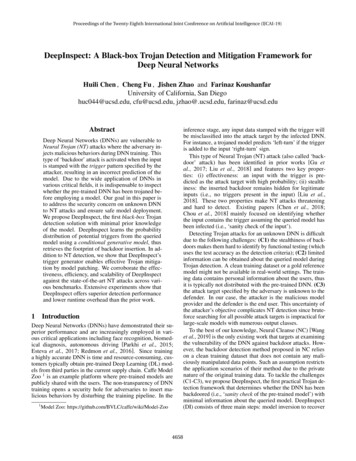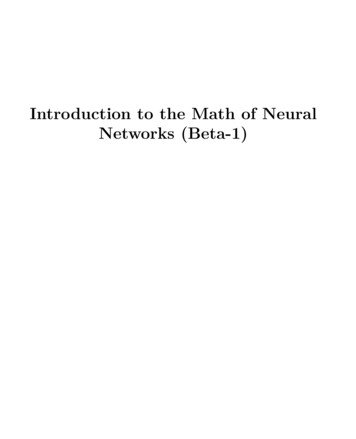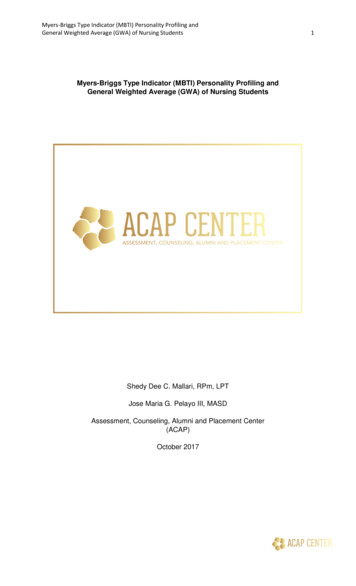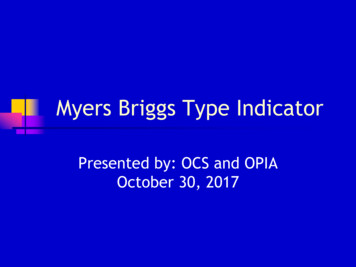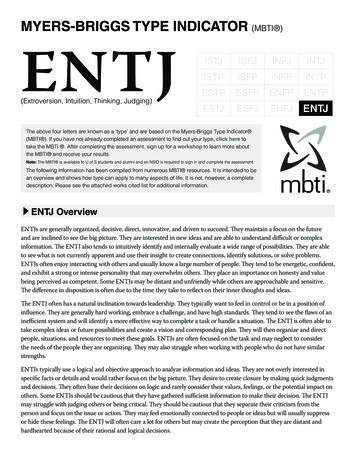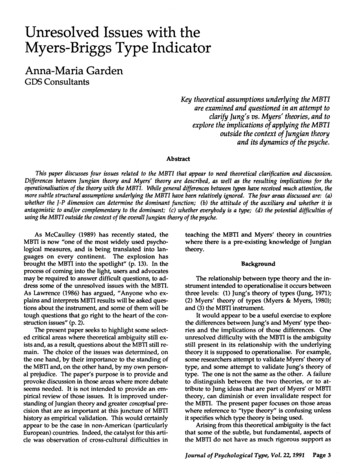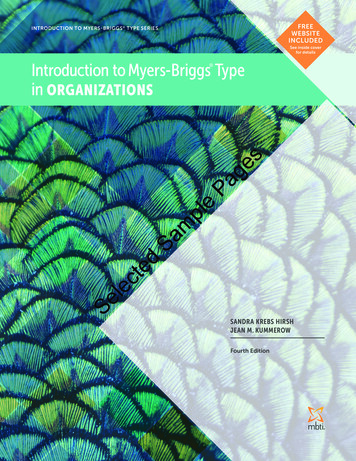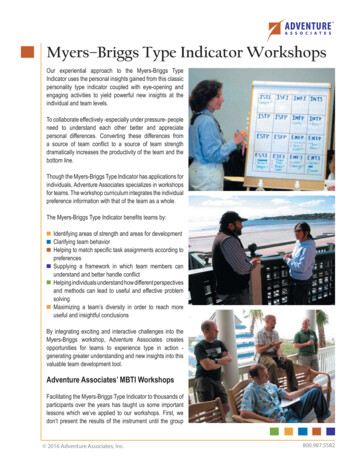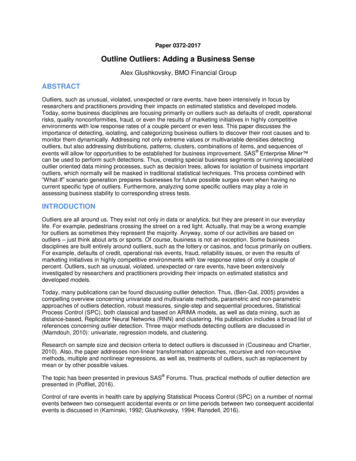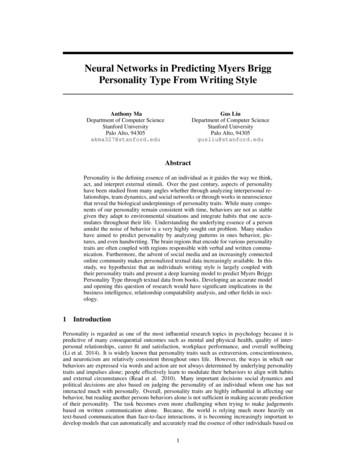
Transcription
Neural Networks in Predicting Myers BriggPersonality Type From Writing StyleGus LiuDepartment of Computer ScienceStanford UniversityPalo Alto, 94305gusliu@stanford.eduAnthony MaDepartment of Computer ScienceStanford UniversityPalo Alto, 94305akma327@stanford.eduAbstractPersonality is the defining essence of an individual as it guides the way we think,act, and interpret external stimuli. Over the past century, aspects of personalityhave been studied from many angles whether through analyzing interpersonal relationships, team dynamics, and social networks or through works in neurosciencethat reveal the biological underpinnings of personality traits. While many components of our personality remain consistent with time, behaviors are not as stablegiven they adapt to environmental situations and integrate habits that one accumulates throughout their life. Understanding the underlying essence of a personamidst the noise of behavior is a very highly sought out problem. Many studieshave aimed to predict personality by analyzing patterns in ones behavior, pictures, and even handwriting. The brain regions that encode for various personalitytraits are often coupled with regions responsible with verbal and written communication. Furthermore, the advent of social media and an increasingly connectedonline community makes personalized textual data increasingly available. In thisstudy, we hypothesize that an individuals writing style is largely coupled withtheir personality traits and present a deep learning model to predict Myers BriggsPersonality Type through textual data from books. Developing an accurate modeland opening this question of research would have significant implications in thebusiness intelligence, relationship compatability analysis, and other fields in sociology.1IntroductionPersonality is regarded as one of the most influential research topics in psychology because it ispredictive of many consequential outcomes such as mental and physical health, quality of interpersonal relationships, career fit and satisfaction, workplace performance, and overall wellbeing(Li et al. 2014). It is widely known that personality traits such as extraversion, conscientiousness,and neuroticism are relatively consistent throughout ones life. However, the ways in which ourbehaviors are expressed via words and action are not always determined by underlying personalitytraits and impulses alone; people effectively learn to modulate their behaviors to align with habitsand external circumstances (Read et al. 2010). Many important decisions social dynamics andpolitical decisions are also based on judging the personality of an individual whom one has notinteracted much with personally. Overall, personality traits are highly influential in affecting ourbehavior, but reading another persons behaviors alone is not sufficient in making accurate predictionof their personality. The task becomes even more challenging when trying to make judgementsbased on written communication alone. Because, the world is relying much more heavily ontext-based communication than face-to-face interactions, it is becoming increasingly important todevelop models that can automatically and accurately read the essence of other individuals based on1
writing alone. Fortunately, studies in neuroscience have revealed close mappings of brain regionsresponsible for personality traits such as extraversion and neuroticism as well as those that arelinked to written communication (Adelstein et al. 2011). Given the highly interconnected natureof neurons, we have reason to believe that underlying patterns of personality can be extracted fromwritten text.Previous personality prediction models have focused on applying general machine learningtechniques and neural networks to predicting the Big-Five personality traits of openness, conscientiousness, extraversion, agreeableness, and neuroticism from social media posts (Schwartz et al.2013). Other studies have incorporated computer vision techniques to predict personality traits fromprofile pictures, handwriting, and other image based data (Liu et al. 2016). While, utilizing textualand image based data from social media websites would be useful in predicting friendship dynamicsin large social networks, they dont reveal the full spectrum of ones behavior. Writing from posts andtweets tend to be in the style of prose and has great variability which allows for better differentiationbetween say introverts and extraverts. Often times, the more challenging task is to pick up nuanceddifferences in individuality and personality traits from more formal and standardized writing stylessuch as essays, emails, or job applications. Furthermore, the studies that focus on the Big-Five traitstend to give a trait by trait picture of an individual, whereas Myers Briggs Personality Type (MBTI)tend to be associated to archetypes that are more easily comparable and have functional applicationsin predicting compatibility in vocation and relationships as well as behavioral tendencies.In this work, we explored a variety of methods to address the personality prediction problem. Westarted by manually building a large corpus mapping excerpts from famous novels with MBTI typesof authors. To gauge the difficulty of identifying MBTI from text, we clustered text segments basedon word embedding similarities to determine whether there existed any non-uniform distributionof personality types. This provides a good starting frame of reference to understand how subtlepersonality traits are when hidden in written data. We then implemented a bag of words feed-forwardneural network as a baseline to understand how simple models in deep-learning can provide insightof hidden personality features. Finally, we delve into a more complex long-short term memory basedrecurrent neural network and aim to build a more generalizable system that can incorporate meaningof writing to determine overall personality types.22.1BackgroundPersonality and Myers-BriggsThe Myers-Briggs Type Indicator (MBTI) is based on Carl Jungs theory of psychological typeswhich states that random variation in behavior is accounted for by the way people use judgement andperception. There are 16 personality types across four dimensions. Extraversion (E) vs Introversion(I) is a measure of how much an individual prefers their outer or inner world. Sensing (S) vs Intuition(N) differentiates those that process information through the five senses versus impressions throughpatterns. Thinking (T) vs Feeling (F) is a measure of preference for objective principles and factsversus weighing the points of view of others. Finally, Judging (J) vs Perceiving (P) differentiatesthose that prefer planned and ordered life versus flexible and spontaneous. Note that these measuresare not binary but rather on a continuum.2
2.2Neural Network and Supervised/Unsupervised Machine Learning BackgroundIn this section, we justify our neural network-based approach and compare it with popular machinelearning methods. We first establish that there is currently scarce existing research that has found themost powerful features for predicting personality from text. From this lack of feature engineering, itis already difficult to use standard machine learning methods to perform this difficult task. Next, it iscertainly conceivable to construct a massive dataset for this task with the appropriate amount of effortand time spent on data collection, allowing neural networks the bandwidth to learn the important andrelevant features while avoiding overfitting. Now, we consider the models themselves. A recurrentneural network takes in the sequential nature of the data with the context from multiple previoustime steps fed to the next timestep. We hypothesize that sentence progression, structure, and flow isas important as content when determining personality type. For example, an introvert may write thesame thing in terms of word choice as an extravert but with very different tone. A concrete exampleis that an introvert may write, It is possible, I think. On the other hand, an extravert may write I thinkit it is possible. The content of each sentence is the same, something that even our baseline bag ofwords model treats as the same, whereas an LSTM has the capability to deduce that the first is morerepresentative of an introvert and the second an extravert. Not only can an LSTM learn what longterm dependencies to incorporate, it can conversely decide what information to forget and ignore ateach time step. Given our dataset of books written by celebrated authors, it is clear that our authorschose each sentence and paragraph structure with great care. We investigate whether those choicesare reflective of personalities.33.1DataOverviewTo train our model, we needed to obtain a data set of text segments associated with the Myers-Briggspersonality type of the author. To manually build this dataset, we first generated a mapping betweenfamous authors and MBTI by using Google API, MBTIDatabase, and BookRiot. After identifyingthe writers, we searched for a book from ten authors for each personality type. Doing so would helpus balance our data such that there is enough variability within a personality type. The books wereobtained from free book repositories such as The Gutenberg Project, Stanford Online Library, andEBookCentral. We then converted these books from PDF format to .txt files using online conversionengines. In total, we were able to manually curate over 750,000 labeled sentences.3
3.2PreprocessingThe .txt files containing the raw book contents were parsed and formatted to remove sentences written in the table of contents, index, publishing detail, and any information that was not written by theauthor. The entire text was then split upon punctuations to generate sentences. We also removednumbers, non-English words, urls, and extraneous information contained in PDF versions. Next, wegenerated data points that were chunks of five sentences - a length that is typical of a short paragraphthat contains appropriate contextual information. Chunk sizes that are too large would be less feasible for personality prediction due to vanishing gradient problems. Excessively small chunks wouldomit important context that is important in capturing features of ones personality. The chunk size remains as a hyperparameter that we would hope to optimize carefully. We represented the sentencesas one-hot vectors corresponding to the words, from which we obtained their GloVe vectors usingpre-trained embeddings. Similarly, we represented our output vectors as one-hot vectors of length16 with a value of 1 for the class and 0s elsewhere.3.3Dataset IssuesInitially we ran our deep-learning model on the full dataset, but found that deep-learning modelwas fitting to the distribution of personality types in our training data rather than learning. In otherwords it always predicted the most common MBTI types while have near zero predictions in the lesscommon ones. It turns out that each book varied greatly in the number of post-processed sentences,and therefore not every personality type had the same number of effective data points. We decided tobalance our data set by determining the minimum number of datapoints across any category and thenrandomly picking this number of points from all 16 MBTI types to build a balanced and shuffleddata set. After pruning, our data set had about 50,000 chunks and a total of approximately 250,000sentences.44.1ModelsUnsupervised Clustering with SVDTo gain a sense of how subtle personality type is encoded into writing, we perform unsupervisedmachine learning to cluster sentences and see whether certain clusters have non-uniform distribution of certain Myers Briggs classification. Every word of a five-sentence chunk was converted toa 50-dimensional glove vector. These vectors were averaged to generate a single 1x50 vector thatrepresents the content of the sentence. SVD was performed to extract the top two singular vectors inwhich we were then able to plot the averaged glove vectors across a 2-dimensional map. The distribution of personality types serve as a null model reference to gain a sense of how subtle personalitytraits are embedded in writing.4.2Bag of words Feed-Forward Neural NetworkWe implemented a bag of words feed-forward neural network as a baseline to the MBTI prediction problem. Effectively, each word of a five-sentence chunk was converted to a 50-dimensionalglove word embedding, averaged together and fed into a standard feed-forward model. The weightsand biases were defined by a 50 x 16 and 1 x 16 matrix respectively given there were 16 possiblepersonality classifications. Weights were initialized with a Xavier initializer, while the biases wereinitialized with zeros. This model was run over 100 epochs. We used a gradient descent optimizerto optimize the loss with a learning rate of 0.001.4.3RNN with LSTMThe main model presented in this paper is a RNN with LSTM. The five sentence chunks wereprocessed into array of words. This array was either truncated or padded with empty strings to beat predefined max sequence length 120, and fed into a recurrent neural network with weights andbiases defined by a 50 x 16 and 1 x 16 matrix respectively. Batch size was set to be 64, and themodel was run over 1700 epochs. Our input was of shape 32 x 120 x 50 and our output was of shape32 x 16. We extracted the last output by timestep and predicted using that tensor.4
4.4Model TuningInitially, we implemented our model with a max sequence length of 240 with batch sizes of 32.After training the model with these parameters, we found that performance was poor and trainingwas very slow. We hypothesized that our model was suffering from a vanishing gradient and thatour batch sizes were too small, and our VM had sufficient memory to handle a larger batch. Thus,we tuned our parameters by decreasing the maximum sequence length and increasing the batch size,which improved both performance and training speed. Another parameter we heavily tuned was thenumber of epochs. Initially, we started with only 100 epochs, but we realized that our error was notquite converging yet, and so we greatly increased the number of epochs to allow the model moreiterations to learn parameters from the data. This was different than in the baseline, where our errorrate leveled off after around 60 or so epochs, and so only 100 epochs were necessary in that case.55.1ResultsSVD VisualizationFrom our SVD analysis, it seems that there are no cluster formations or identifiable patterns in theaverage GloVe vectors for each data point. This indicates to us that our task is nontrivial, as a lowdimensional representation of the data yields no meaningful interpretations. This further supports theneed to use a neural network to capture the interactions between the vectors at their high dimensions.5
5.2BaselineOur baseline BOW feed forward neural network performed quite well with an accuracy of around28%. As we can see from the confusion matrix where the y-axis is the true labels and the x-axis isthe predicted classes, the diagonal of true positives is heavily weighted in comparison to every othervalue. We scaled each row by the sum of the row, therefore calculating the proportion of each classwe predicted for each true label. We can see that the model has difficulty distinguishing the INTJ andESFP personality types with a lot of false negatives and false negatives. Moreover, there is a goodamount of noise in the non-diagonal entries. With such a simple model, we can see that we havealready captured a significant portion of the distinguishing features between personality types inwriting. The advantages of this sort of approach is that the model is simple and easy to implement,as well as relatively quick to train and tune. However, the disadvantages of such a simple modelare clearly that it has limited capabilities, and it does not take into account the sequential nature ofsentences.6
5.3RNN with LSTM(a) Confusion matrix at epoch 1700(b) Training and test accuracy vs epochs7
Our best RNN model with LSTM significantly outperformed our feed forward baseline network,with an accuracy of 37%. We can see in the confusion matrix that the noise around the diagonal issignificantly reduced. Interestingly, we found that for the first few hundred epochs, a diagonal doesnot appear to materialize in the confusion matrix. In fact, the model seemed to only predict a fewclasses and ignore the rest, resulting in a very low accuracy. After several hundred epochs, we beginto see a heavily weighted diagonal appear that is definitively better than the baseline. We concludethat the LSTM learns at a much slower rate than our baseline, needing more passes over the data toeffectively learn distinguishing features. However, this allows for the potential of more informationto be encoded in the parameters. We also notice that our model begins to overfit the training data,calling for the need for future regularization and dropout implementation.6DiscussionWe trained a recurrent neural network with LSTM units for predicting MBTI personality type usingexcerpts from novels. Using only five sentences of text, this model is able to predict the most likelypersonality type of a writer. Our model does well at predicting overall personality trends but can usemore work in developing more sophisticated neural networks, well rounded evaluation metrics, andexpansive data sets. This work adds upon existing deep-learning models that predict other featuresof personality as well as the work that has been done through supervised machine learning approach.It is possible, that the integration of methods would lead to the most accurate system in personalityprediction which could lead to widespread applications in social network theory and psychology.7ConclusionOur experiments show that neural networks achieve a significant level of effectiveness predictingpersonality from written text. The best model of a dynamic RNN with LSTM predicted with anaccuracy up to 37%. We achieved these results after some careful tuning of the maximum sequencelength to address the vanishing gradient problem. We postulate that we have built a solid frameworkand exploration into this task that can be built upon and extended with several ideas that we willdiscuss in the next section.8Future StepsWhile our models demonstrate that neural networks can predict MBTI from written text effectively,it has yet to be seen if more complex models can achieve better results on the same task. For example, introducing bidirectionality to our RNNs can incorporate future information along with pastinformation for any given token, which could improve our results even further. We also hypothesizethat a more complex loss function could yield better training. Intuitively, it does not make senseto treat all classifications as disjoint and penalize the same way. In particular, a misclassificationof INFJ as ISFJ should not be penalized as much as a misclassification of INFJ as ESTP. Thus, wepropose exploration of a more suitable weighted loss function by personality dimension for our task,one that possibly computes cross-entropy by letter and sums up the individual losses. This would allow our model to learn more nuanced differences between personality categories and perform morefinely grained steps. A more comprehensive hyperparameter grid search could be useful as well,given the appropriate time and resources to do so. The hyperparameters we think could still be optimized are chunk length and hidden size. In addition, we could implement regularization and dropoutrate to avoid overfitting our dataset. Finally, our dataset could be expanded to include many moresentences for each personality type. With a large enough dataset, it is possible to segment the databy genre, time period, or topic so that we could reduce the number of variability that causes noise inthe data. By doing so, we can ensure that our model is learning personality with high probability asopposed to other factors.8
9References[1] Adelstein, Jonathan S. et al. Personality Is Reflected in the Brains Intrinsic Functional Architecture. Ed.Mitchell Valdes-Sosa. PLoS ONE 6.11 (2011): e27633. PMC. Web. 19 Mar. 2017.[2] Champa, H. N., and Dr. K R Anandakumar. ”Artificial Neural Network for Human Behavior Predictionthrough Handwriting Analysis.” International Journal of Computer Applications 2.2 (2010): 36-41. Web.[3] Kalghatgi MP, Ramannavar M, Sidnal N (2015) A Neural Network Approach to Personality Predictionbased on the Big-Five Model. International Journal of Innovative Research in Advanced Engineering (IJIRAE)[4] Li L, Li A, Hao B, Guan Z, Zhu T (2014) Predicting Active Users’ Personality Based on Micro-BloggingBehaviors. PLoS ONE 9(1): e84997. doi:10.1371/journal.pone.0084997[5] Liu L, Pietro D, Samani Z, Moghaddam M, Ungar L. Analyzing Personality through Social Media ProfilePicture Choice. AAAI Digital Library (2016) Web.[6] Read, Stephen J., Brian M. Monroe, Aaron L. Brownstein, Yu Yang, Gurveen Chopra, and Lynn C. Miller.”A Neural Network Model of the Structure and Dynamics of Human Personality.” Psychological Review 117.1(2010): 61-92. Web.[7] Schwartz HA, Eichstaedt JC, Kern ML, Dziurzynski L, Ramones SM, Agrawal M, et al. (2013) Personality,Gender, and Age in the Language of Social Media: The Open-Vocabulary Approach. PLoS ONE 8(9): e73791.doi:10.1371/journal.pone.0073791[8] Scott, Kate. ”The Myers-Briggs Types of 101 Famous Authors.” BOOK RIOT. N.p., 11 Nov. 2015. Web.19 Mar. 2017.[9] ”The MBTI Database — Personality Profiling.” The MBTI Database — Personality Profiling. N.p., n.d.Web. 19 Mar. 2017.9
2.1 Personality and Myers-Briggs The Myers-Briggs Type Indicator (MBTI) is based on Carl Jungs theory of psychological types which states that random variation in behavior is accounted for by the way people use judgement and perception. There are 16 personality types
